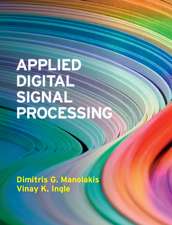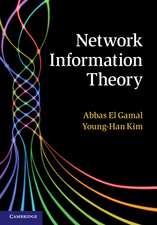Rate-Quality Optimized Video Coding: The Springer International Series in Engineering and Computer Science, cartea 486
Autor Yoo-Sok Sawen Limba Engleză Hardback – 30 noi 1998
In Part I (Chapters 1 to 4) the non-stationarity of digital video is discussed. Since the non-stationary nature is also inherited from algorithmic properties of international video coding standards, which are a combination of statistical coding techniques, the video rate management techniques of these standards are explored. Although there is a series of known video rate control techniques, such as picture rate variation, frame dropping, etc., these techniques do not view the matter as an optimization between rate and quality. From the view of rate-quality optimization, the quantizer is the sole means of controling rate and quality. Thus, quantizers and quantizer control techniques are analyzed, based on the relationship of rate and quality.
In Part II (Chapters 5 and 6), as a coherent approach to non-stationary video, established but still thriving nonlinear techniques are applied to video rate-quality optimization such as artificial neural networks including radical basis function networks, and fuzzy logic-based schemes. Conventional linear techniques are also described before the nonlinear techniques are explored. By using these nonlinear techniques, it is shown how they influence and tackle the rate-quality optimization problem. Finally, in Chapter 7 rate-quality optimization issues are reviewed in emerging video communication applications such as video transcoding and mobile video. This chapter discusses some new issues and prospects of rate and quality control in those technology areas.
Rate-Quality Optimized Video Coding is an excellent reference and can be used for advanced courses on the topic.
| Toate formatele și edițiile | Preț | Express |
|---|---|---|
| Paperback (1) | 636.30 lei 6-8 săpt. | |
| Springer Us – 4 oct 2012 | 636.30 lei 6-8 săpt. | |
| Hardback (1) | 642.68 lei 6-8 săpt. | |
| Springer Us – 30 noi 1998 | 642.68 lei 6-8 săpt. |
Din seria The Springer International Series in Engineering and Computer Science
- 24%
 Preț: 1041.98 lei
Preț: 1041.98 lei - 20%
 Preț: 643.50 lei
Preț: 643.50 lei - 18%
 Preț: 1225.62 lei
Preț: 1225.62 lei - 18%
 Preț: 965.02 lei
Preț: 965.02 lei - 20%
 Preț: 646.12 lei
Preț: 646.12 lei - 18%
 Preț: 948.79 lei
Preț: 948.79 lei - 20%
 Preț: 646.62 lei
Preț: 646.62 lei - 15%
 Preț: 637.46 lei
Preț: 637.46 lei - 20%
 Preț: 643.83 lei
Preț: 643.83 lei - 18%
 Preț: 949.23 lei
Preț: 949.23 lei - 20%
 Preț: 644.48 lei
Preț: 644.48 lei - 20%
 Preț: 994.92 lei
Preț: 994.92 lei - 20%
 Preț: 645.97 lei
Preț: 645.97 lei - 18%
 Preț: 946.87 lei
Preț: 946.87 lei - 20%
 Preț: 995.57 lei
Preț: 995.57 lei - 18%
 Preț: 956.99 lei
Preț: 956.99 lei - 20%
 Preț: 644.98 lei
Preț: 644.98 lei - 15%
 Preț: 649.54 lei
Preț: 649.54 lei - 18%
 Preț: 950.21 lei
Preț: 950.21 lei - 18%
 Preț: 1221.38 lei
Preț: 1221.38 lei - 18%
 Preț: 957.62 lei
Preț: 957.62 lei - 15%
 Preț: 643.99 lei
Preț: 643.99 lei - 18%
 Preț: 948.47 lei
Preț: 948.47 lei - 18%
 Preț: 947.35 lei
Preț: 947.35 lei - 20%
 Preț: 1284.65 lei
Preț: 1284.65 lei - 20%
 Preț: 1628.31 lei
Preț: 1628.31 lei - 20%
 Preț: 1285.78 lei
Preț: 1285.78 lei
Preț: 642.68 lei
Preț vechi: 756.09 lei
-15% Nou
Puncte Express: 964
Preț estimativ în valută:
122.99€ • 133.55$ • 103.31£
122.99€ • 133.55$ • 103.31£
Carte tipărită la comandă
Livrare economică 22 aprilie-06 mai
Preluare comenzi: 021 569.72.76
Specificații
ISBN-13: 9780792383765
ISBN-10: 0792383761
Pagini: 183
Ilustrații: XXV, 183 p.
Dimensiuni: 155 x 235 x 14 mm
Greutate: 0.48 kg
Ediția:1999
Editura: Springer Us
Colecția Springer
Seria The Springer International Series in Engineering and Computer Science
Locul publicării:New York, NY, United States
ISBN-10: 0792383761
Pagini: 183
Ilustrații: XXV, 183 p.
Dimensiuni: 155 x 235 x 14 mm
Greutate: 0.48 kg
Ediția:1999
Editura: Springer Us
Colecția Springer
Seria The Springer International Series in Engineering and Computer Science
Locul publicării:New York, NY, United States
Public țintă
ResearchCuprins
I Background of video rate-quality optimisation.- 1. Non-Stationary Nature of Digital Video.- 2. Rate-Quality Control In International Standards.- 3. Quantiser Control For Rate-Quality Optimisation.- 4. Linear Predictive Video Rate Estimation and Control.- II Nonlinear signal processing approaches to video rate-quality optimisation.- 5. Nonlinear Predictive Video Rate Estimation and Control.- 6. Fuzzy Logic-Based Video Rate Estimation and Control.- 7. Advanced Topics.- References.- Appendices A-Video sequences used in simulations.













